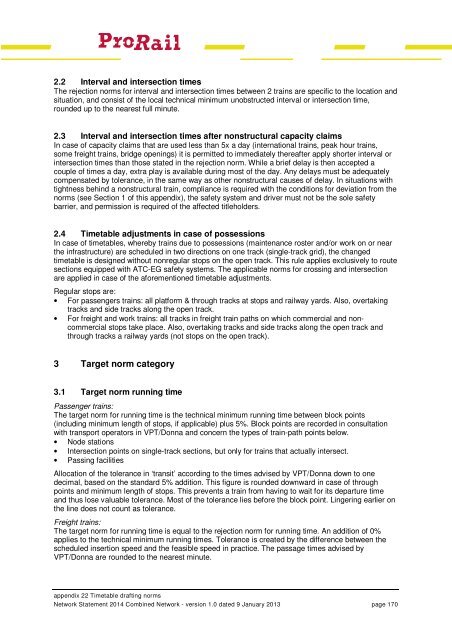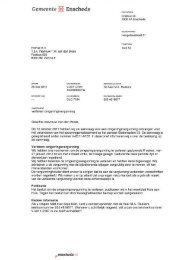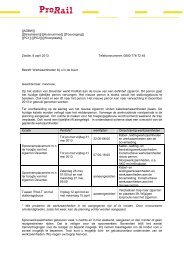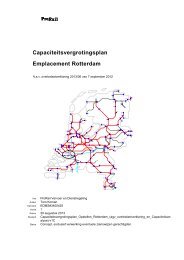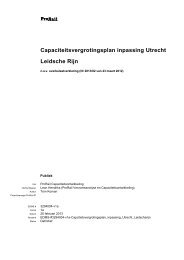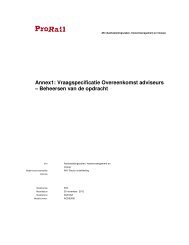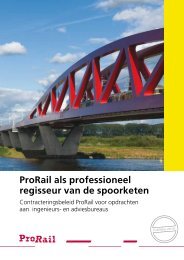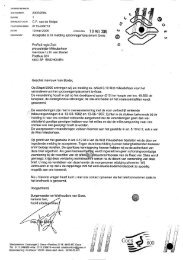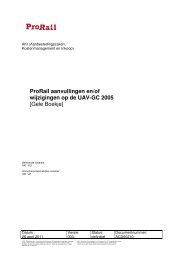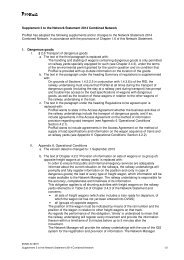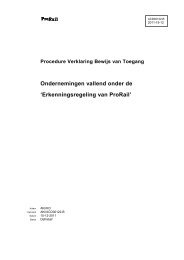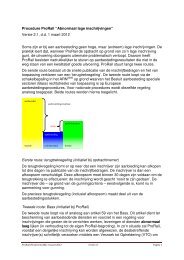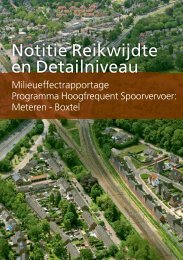Network Statement 2014 - ProRail
Network Statement 2014 - ProRail
Network Statement 2014 - ProRail
- No tags were found...
Create successful ePaper yourself
Turn your PDF publications into a flip-book with our unique Google optimized e-Paper software.
2.2 Interval and intersection timesThe rejection norms for interval and intersection times between 2 trains are specific to the location andsituation, and consist of the local technical minimum unobstructed interval or intersection time,rounded up to the nearest full minute.2.3 Interval and intersection times after nonstructural capacity claimsIn case of capacity claims that are used less than 5x a day (international trains, peak hour trains,some freight trains, bridge openings) it is permitted to immediately thereafter apply shorter interval orintersection times than those stated in the rejection norm. While a brief delay is then accepted acouple of times a day, extra play is available during most of the day. Any delays must be adequatelycompensated by tolerance, in the same way as other nonstructural causes of delay. In situations withtightness behind a nonstructural train, compliance is required with the conditions for deviation from thenorms (see Section 1 of this appendix), the safety system and driver must not be the sole safetybarrier, and permission is required of the affected titleholders.2.4 Timetable adjustments in case of possessionsIn case of timetables, whereby trains due to possessions (maintenance roster and/or work on or nearthe infrastructure) are scheduled in two directions on one track (single-track grid), the changedtimetable is designed without nonregular stops on the open track. This rule applies exclusively to routesections equipped with ATC-EG safety systems. The applicable norms for crossing and intersectionare applied in case of the aforementioned timetable adjustments.Regular stops are:• For passengers trains: all platform & through tracks at stops and railway yards. Also, overtakingtracks and side tracks along the open track.• For freight and work trains: all tracks in freight train paths on which commercial and noncommercialstops take place. Also, overtaking tracks and side tracks along the open track andthrough tracks a railway yards (not stops on the open track).3 Target norm category3.1 Target norm running timePassenger trains:The target norm for running time is the technical minimum running time between block points(including minimum length of stops, if applicable) plus 5%. Block points are recorded in consultationwith transport operators in VPT/Donna and concern the types of train-path points below.• Node stations• Intersection points on single-track sections, but only for trains that actually intersect.• Passing facilitiesAllocation of the tolerance in ‘transit’ according to the times advised by VPT/Donna down to onedecimal, based on the standard 5% addition. This figure is rounded downward in case of throughpoints and minimum length of stops. This prevents a train from having to wait for its departure timeand thus lose valuable tolerance. Most of the tolerance lies before the block point. Lingering earlier onthe line does not count as tolerance.Freight trains:The target norm for running time is equal to the rejection norm for running time. An addition of 0%applies to the technical minimum running times. Tolerance is created by the difference between thescheduled insertion speed and the feasible speed in practice. The passage times advised byVPT/Donna are rounded to the nearest minute.appendix 22 Timetable drafting norms<strong>Network</strong> <strong>Statement</strong> <strong>2014</strong> Combined <strong>Network</strong> - version 1.0 dated 9 January 2013 page 170


